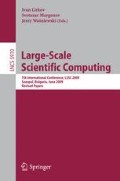Abstract
The study aims at examining the ability and the limitations of US EPA Models 3 system to adequately reproduce air pollution episodes and to evaluate the role of different processes in the PM10 pattern formation. The case study focuses on the meteorological situation in Germany in February and March of 2003 during which three major PM10 episodes could be identified.
The simulated meteorological fields agree well with the patterns described in the case study definition. The simulated PM10 concentrations are compared with measurements from the EMEP stations in Germany. The Integrated Process Rate Analysis function of CMAQ is applied for clarifying the role of different processes of transport and transformation in forming PM10 concentration peaks.
Access this chapter
Tax calculation will be finalised at checkout
Purchases are for personal use only
Preview
Unable to display preview. Download preview PDF.
References
Builtjes, P.J.H., van Loon, M., Schaap, M., Teeuwisse, S., Visschedijk, A.J.H., Bloos, J.P.: Project on the modelling and verification of ozone reduction strategies: contribution of TNO-MEP, TNO-report, MEP-R2003/166, Apeldoorn, The Netherlands (2003)
Byun, D., Ching, J.: Science Algorithms of the EPA Models-3 Community Multiscale Air Quality (CMAQ) Modeling System. EPA Report 600/R-99/030, Washington, DC (1999)
Byun, D., Schere, K.L.: Review of the Governing Equations, Computational Algorithms, and Other Components of the Models-3 Community Multiscale Air Quality (CMAQ) Modeling System. Applied Mechanics Reviews 59(2), 51–77 (2006)
CEP: Sparse Matrix Operator Kernel Emission (SMOKE) Modeling System, University of Carolina, Carolina Environmental Programs, Research Triangle Park, North Carolina (2003)
Coats Jr., C.J., Houyoux, M.R.: Fast Emissions Modeling with the Sparse Matrix Operator Kernel Emissions Modeling System, The Emissions Inventory: Key to Planning, Permits, Compliance, and Reporting, Air and Waste Management Association, New Orleans (September 2006)
Dennis, R.L., Byun, D.W., Novak, J.H., Galluppi, K.J., Coats, C.J., Vouk, M.A.: The Next Generation of Integrated Air Quality Modeling: EPA’s Models-3. Atmosph. Environment 30, 1925–1938
Dudhia, J.: A non-hydrostatic version of the Penn State/NCAR Mesoscale Model: validation (1993)
Gery, M.W., Whitten, G.Z., Killus, J.P., Dodge, M.C.: A Photochemical Kinetics Mechanism for Urban and Regional Scale Computer Modeling. Journal of Geophysical Research 94, 12925–12956 (1989)
Grell, G.A., Dudhia, J., Stauffer, D.R.: A description of the Fifth Generation Penn State/NCAR Mesoscale Model (MM5). NCAR Technical Note, NCAR TN-398-STR, 138 p. (1994)
Houyoux, M.R., Vukovich, J.M.: Updates to the Sparse Matrix Operator Kernel Emission (SMOKE) Modeling System and Integration with Models-3, The Emission Inventory: Regional Strategies for the Future, Raleigh, NC, Air and Waste Management Association (1999)
Nenes, A., Pandis, S.N., Pilinis, C.: ISORROPIA: A new thermodynamic equilibrium model for multiphase multicomponent inorganic aerosols. Aquat. Geoch. 4, 123–152 (1998)
Stern, R., Builtjes, P., Schaap, M., Timmermans, R., Vautard, R., Hodzic, A., Memmesheimer, M., Feldmann, H., Renner, E., Wolke, R., Kerschbaumer, A.: A model inter-comparison study focussing on episodes with elevated PM10 concentrations. Atmospheric Environment 42, 4567–4588 (2008)
Visschedijk, A.J.H., Zandveld, P.Y.J., Denier van der Gon, H.A.C.: A High Resolution Gridded European Emission Database for the EU Integrate Project GEMS, TNO-report 2007-A-R0233/B, Apeldoorn, The Netherlands (2007)
Author information
Authors and Affiliations
Editor information
Editors and Affiliations
Rights and permissions
Copyright information
© 2010 Springer-Verlag Berlin Heidelberg
About this paper
Cite this paper
Todorova, A. et al. (2010). Numerical Study of Some High PM10 Levels Episodes. In: Lirkov, I., Margenov, S., Waśniewski, J. (eds) Large-Scale Scientific Computing. LSSC 2009. Lecture Notes in Computer Science, vol 5910. Springer, Berlin, Heidelberg. https://doi.org/10.1007/978-3-642-12535-5_25
Download citation
DOI: https://doi.org/10.1007/978-3-642-12535-5_25
Publisher Name: Springer, Berlin, Heidelberg
Print ISBN: 978-3-642-12534-8
Online ISBN: 978-3-642-12535-5
eBook Packages: Computer ScienceComputer Science (R0)

